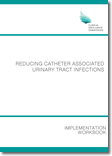Implementation Steps
The following steps outline what needs to be done to prepare for the implementation of any new resources.
Find out what is going on
Before adopting any of the tools, it is important to establish current catheter utilisation, clinical practices and who needs to be targeted for improvement. Pinpoint exactly what are the practice gaps and what processes need to be improved. Consider using the CAUTIs investigation tool to help with this.
Seek executive-level support to implement new resources
Challenging and changing current clinical practice requires engagement and support from hospital leadership [1]. Involving the Executive will ensure awareness across all levels of staff and may enable resource implementation to be prioritised on the organisation's workplan. Hospital leadership also may be able to allocate resources to support the implementation of the initiative.
Seek support from clinical leaders
For some units the implementation of the new resources may mean a change from current practice. Both medical and nursing leaders in units/facilities need to be aware of and support any changes to clinical processes before implementation occurs. In mixed units, all clinical specialities should be involved in developing the local implementation plan to ensuring adherence to changed clinical processes and consistency across specialities.
Form an implementation team
The implementation team should involve both medical and nursing staff and should include:
- the clinical disciplines and specialities in the unit/facility who are typically involved in the relevant clinical process;
- clinical educators from the unit/facility;
- the local continence and/or urology service; and
- the local infection prevention and control, infectious disease or clinical microbiology service
Identify an implementation lead
Successful practice change is driven by local ownership of the need to change and ownership of the unit's specific change journey [2]. In other words, successful implementation and practice improvement will happen if clinicians in the unit are aware of the need to improve practice and want change to happen. The ideal implementation lead is someone is from the unit who is in a leadership role (e.g. clinical nurse specialist or educator) rather than someone external to the unit. The implementation lead should be part of the implementation team.

Reducing Catheter Associated Urinary Tract Infections
Implementation Workbook
The CEC has produced an implementation workbook to assist units/facilities who are interested in implementing any of the decision support tools produced as part of this project.
Download PDF ~332KB
[1] Klaber, R.E. and D. Roland, Delivering quality improvement: the need to believe it is necessary. Archives of Diseases in Childhood, 2013. 99: p. 175-179.
[2] Mountford, J. and K. Shojania, Refocusing quality measurement to best support quality improvement: local ownership of quality measurement by clinicians. BMJ Quality & Safety, 2012. 21(6): p. 519-23.
